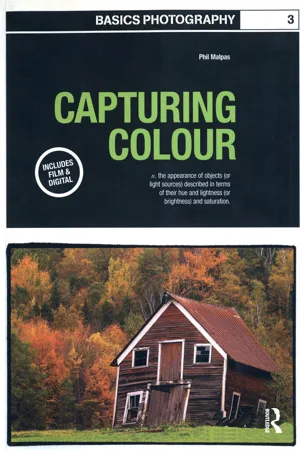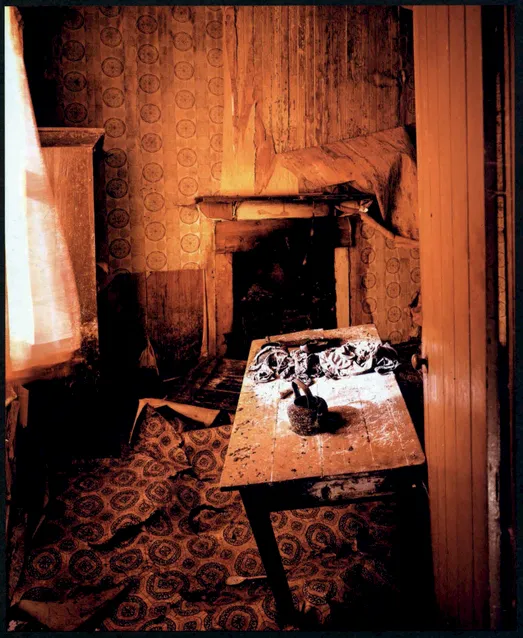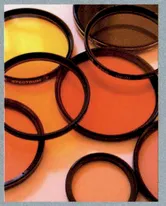
This is a test
- 176 pages
- English
- ePUB (mobile friendly)
- Available on iOS & Android
eBook - ePub
Capturing Colour
Book details
Book preview
Table of contents
Citations
About This Book
Basics Photography 03: Capturing Colour gives readers a comprehensive introduction to the subject of colour and how to master its use in the process of photographic image-making. The topics discussed range from basic colour theory to the colour temperature of light and how to use colour to maximize the impact of compositions. A full and intimate understanding of colour is vital to the creation of dramatic, emotive and powerful photographic images. The way we choose to use colour will greatly influence the success of our image-making.
Frequently asked questions
At the moment all of our mobile-responsive ePub books are available to download via the app. Most of our PDFs are also available to download and we're working on making the final remaining ones downloadable now. Learn more here.
Both plans give you full access to the library and all of Perlego’s features. The only differences are the price and subscription period: With the annual plan you’ll save around 30% compared to 12 months on the monthly plan.
We are an online textbook subscription service, where you can get access to an entire online library for less than the price of a single book per month. With over 1 million books across 1000+ topics, we’ve got you covered! Learn more here.
Look out for the read-aloud symbol on your next book to see if you can listen to it. The read-aloud tool reads text aloud for you, highlighting the text as it is being read. You can pause it, speed it up and slow it down. Learn more here.
Yes, you can access Capturing Colour by Phil Malpas in PDF and/or ePUB format, as well as other popular books in Art & Photography. We have over one million books available in our catalogue for you to explore.
Information
Filtration

Abandoned House, Scotland
The colour contrast in this image is caused by the sunlight shining through the curtains on the left, light that was far warmer than the film was expecting. This adds to the atmosphere and the use of filtration to try to correct it would have been a mistake.
The colour contrast in this image is caused by the sunlight shining through the curtains on the left, light that was far warmer than the film was expecting. This adds to the atmosphere and the use of filtration to try to correct it would have been a mistake.
Photographer: Phil Malpas.
Technical summary: Ebony SV45TE 4×5 field camera with Schneider Super-Angulon 90mm f8 lens, exposure 15 seconds at F32, Fuji Velvia 50 rated at ISO 50, no filtration.
An ability to successfully and confidently utilise filters is an essential skill for those wishing to excel in colour photography. Ironically when filters are used properly a key aim is to produce an image where it is impossible to tell that one has been used. The main reason for selecting a filter in a particular situation is to enable the film or digital camera to capture the subject as the photographer sees it. Filters are used to overcome specific limitations in the photographic process and aid the communication of the photographer’s vision to the viewer of the final result.
The filters discussed in this section are of two main types. There are those that actually change the colour of the final image and those that are used to reduce the subject contrast range in order to capture full colour throughout the composition.
Of these, the neutral density graduated filters, which are used to reduce contrast range are useful for both film and digital users. The remaining filters are not required by those using digital cameras. Digital users can utilise white balance to deal with any colour correction they need to achieve. In fact the auto white balance functionality of most modern digital cameras would partially negate the impact of colour correction filters anyway.
There is one special filter that falls outside the two main categories and that is the polarising filter. An essential tool for digital and film users alike, the polariser can enhance an image in ways that cannot be achieved in any other way.
There are numerous filters and filter systems on the market today, produced by manufacturers from all over the world. It is important to purchase the highest quality filters you can afford, any compromise here will directly affect the quality of your results. In general the most expensive filters are the best quality and will be more likely to achieve the objective of being unnoticeable in the final image.
The most important thing to remember is that even using the most expensive filters will not drag a fantastic result from a poor subject. Filters will help you to realise your vision, they will not create it for you!
Filter systems
There are two major approaches to filtration available, each of which has a number of advantages and disadvantages associated with it. A lot depends on your individual requirements as to the best approach to take, particularly the number of lenses and the type of camera you use.

Circular, screw-on filters
Many filters are available in circular form and have a filter thread equivalent to a particular diameter in millimetres. Each lens that you own will have its filter thread diameter marked in millimetres near the front element. If you own a number of lenses with different filter thread sizes, you will need to purchase multipl...
Table of contents
- Cover
- Title Page
- Copyright Page
- Contents
- How to get the most out of this book
- Introduction
- Colour theory
- Vision
- Light
- Photographic colour
- Filtration
- Using colour
- Processing and printing
- Colour captured
- Conclusion
- Glossary
- Acknowledgements, contacts and credits